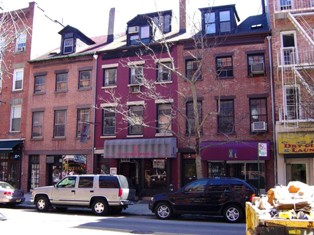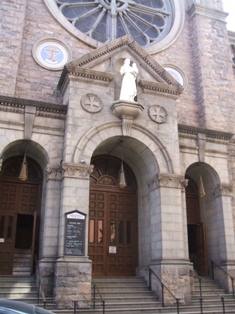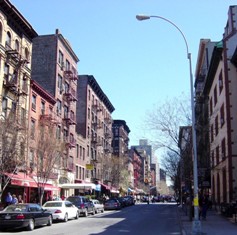
The South Village—A Distinguished History, Largely Unrecognized
 The South Village is an area rich in architectural, cultural, and historic resources, distinct from (though connected to) those of its surrounding historic communities, such as Greenwich Village, SoHo, and NoHo. In contrast to its surroundings, however, the area is currently for the most part lacking in any kind of protection or formally documented recognition. This is partly due to the historic resources being somewhat untraditional by conventional standards. Much of this area’s history is defined by tenements and immigrants, particularly Italian-Americans; by speakeasies, jazz clubs, beatnik coffeehouses, and folk music clubs from the area’s counter-cultural heyday of the 1920s through the 1960s; by crooked streets and tiny houses which may have been altered but which still retain their charm and architectural distinction. The South Village is an area rich in architectural, cultural, and historic resources, distinct from (though connected to) those of its surrounding historic communities, such as Greenwich Village, SoHo, and NoHo. In contrast to its surroundings, however, the area is currently for the most part lacking in any kind of protection or formally documented recognition. This is partly due to the historic resources being somewhat untraditional by conventional standards. Much of this area’s history is defined by tenements and immigrants, particularly Italian-Americans; by speakeasies, jazz clubs, beatnik coffeehouses, and folk music clubs from the area’s counter-cultural heyday of the 1920s through the 1960s; by crooked streets and tiny houses which may have been altered but which still retain their charm and architectural distinction.
The South Village’s distinctive architectural fabric developed in several stages. The first, from roughly the 1820s to the 1850s, was the area’s first development as a (sub)urban refuge from the more settled areas of Lower Manhattan. During this period scores of federal and Greek Revival rowhouses were built, and the survivors exist today in every form from nearly pristine to almost unrecognizably altered, with most somewhere in the middle.
The second stage, from the just before the Civil War until just before World War I, coincided with waves of immigration transforming the area, and the building of countless tenements of all architectural styles, and of pre-law, old law, and new law configurations. This most common of building types in the area includes a surprising number of buildings with meticulous architectural detail, from the cornices to brickwork to elaborately crafted fire escape and entryway railing ironwork, to cast-iron storefronts. A remarkable number of these buildings retain a significant amount of their original details and materials in  excellent condition. This era also saw a significant number of commercial/industrial structures built, generally of a brick or masonry form similar to the neighboring tenements, and often housing by day the same laborers who populated the nearby tenements by night. The latter part of this era also saw the erection of some remarkable and unique examples of reform housing in the South Village. excellent condition. This era also saw a significant number of commercial/industrial structures built, generally of a brick or masonry form similar to the neighboring tenements, and often housing by day the same laborers who populated the nearby tenements by night. The latter part of this era also saw the erection of some remarkable and unique examples of reform housing in the South Village.
The third stage of the South Village’s development, from World War I through the end of World War II, saw the erection of a smaller number of commercial/industrial structures, especially garages, but its greatest imprint upon the built environment came in the form of alterations to existing buildings. As foreign immigration waned in the 1920s due to restrictive immigration laws, the South Village attracted a new kind of immigrant, the artist, and America’s premier bohemian neighborhood was born. Federal and Greek revival rowhouses had artist studio attics added on top, and tenements were rehabilitated and joined together to form communal courtyards and gardens (this was partly inspired by nearby MacDougal –Sullivan Gardens, located within the South Village but already a designated NYC historic district). Other older houses and tenements were retrofitted for new residential or commercial uses, the clearest visible manifestation of which is often the still-extant deco or moderne fire escapes that were added at this time.
It is also during this era that many of the area’s small theaters, of which there are at least a half dozen, were created, generally carved out of existing residential or commercial structures. A smaller number of buildings were built or altered during the post-war period, but it is possible to see entire blocks in the South Village that look more or less as they did 75 to 150 years ago.
Other defining physical characteristics of the area include the very unusual street patterns, which reflects not merely the static preservation of the Village’s pre-1811 grid, but the streets’ evolution over time – streets were widened, extended, and added as the City grew through the South Village, creating parks, plazas, dead-end views, strangely shaped buildings and oddly-exposed facades which define the area’s unusual visual charms and are which extraordinary for New York.
 The rich cultural history of the area reflects its physical development. Originally home to a merchant class in the early 19th century, by the late 19th century the area was dominated by immigrants, largely from Italy. The Italian immigrants built their own distinct parishes, to distinguish them not only from their Protestant neighbors on the north side of Washington Square (in Greenwich Village), but their Irish neighbors in the South Village. By the late 19th century, Italians outnumbered the Irish in the area, but were not preeminent in the local church hierarchy, especially the parish of St. Patrick’s, which covered this area. In response, the Italian-American communities of the South Village built Our Lady of Pompeii and St. Anthony of Padua, which remain the area’s defining religious edifices, and their impressive buildings continue to dominate the local skyline as they would in any Italian hill town. The tenements surrounding them preserve and tell a remarkable story of immigrant struggle, survival, and success. The rich cultural history of the area reflects its physical development. Originally home to a merchant class in the early 19th century, by the late 19th century the area was dominated by immigrants, largely from Italy. The Italian immigrants built their own distinct parishes, to distinguish them not only from their Protestant neighbors on the north side of Washington Square (in Greenwich Village), but their Irish neighbors in the South Village. By the late 19th century, Italians outnumbered the Irish in the area, but were not preeminent in the local church hierarchy, especially the parish of St. Patrick’s, which covered this area. In response, the Italian-American communities of the South Village built Our Lady of Pompeii and St. Anthony of Padua, which remain the area’s defining religious edifices, and their impressive buildings continue to dominate the local skyline as they would in any Italian hill town. The tenements surrounding them preserve and tell a remarkable story of immigrant struggle, survival, and success.
By the 1920s, however, as the Village had fallen out of fashion with New York’s patricians, artists, bohemians, and radical thinkers began to populate the area, and the institutions which served them, such as jazz clubs and speakeasies became commonplace throughout the area. By the 1950s and 60s, many of these had become coffeehouses and folk clubs for hippies, beatniks, and artists. These South Village establishments were frequented by some of the most significant players in these cultural movements, and were the scene of some of their most important moments.
The danger currently facing the South Village is one of increasing development pressure, potentially resulting in demolition or alteration of historic structures, and the addition of new, out-of-context ones. In just the last few years, a home which once housed Edgar Allen Poe on 3rd Street was destroyed to make way for a 200-plus foot tall institutional development, and several other typical houses and tenements have been demolished, largely on the district’s edges, to make way for new, and not necessarily very sensitive, construction. Insensitive renovations also take a toll, especially as many of the tenements are heavily ornamented, and Local Law 10 regulations often result in the ornament’s removal. Development pressure is now encroaching from all sides as the area experiences tremendous increases in real estate value. The South Village’s appealing location for private and institutional development combined with its low scale and lack of historic district protections or zoning restrictions make this area ripe for very significant development.
 In spite of this, however, and some insensitive new developments at its edges notwithstanding, the area retains a remarkable continuity and integrity, and posses an extraordinarily well-preserved urban landscape that tells a story not to be found anywhere else. GVSHP has been working with a broad coalition of community groups and leaders, elected officials, and local institutions on advancing a proposal for historic district designation for the South Village. The report documents the South Village’s architectural, cultural, and historic merits, identifies its themes, showcases its highlights, placing it in a broader context of our city’s, state’s and nation’s development and argues its significance. The report was submitted to the NYC Landmarks Preservation Commission at the end of 2006 as part of a request for designation of the area as a New York City Historic (landmark) District. Historic District designation will recognize and preserve the Siouth Village's unique architectural, cultural, and historical contributions, and would be the first immigrant history and working-class architecture-based historic district in New York City. In spite of this, however, and some insensitive new developments at its edges notwithstanding, the area retains a remarkable continuity and integrity, and posses an extraordinarily well-preserved urban landscape that tells a story not to be found anywhere else. GVSHP has been working with a broad coalition of community groups and leaders, elected officials, and local institutions on advancing a proposal for historic district designation for the South Village. The report documents the South Village’s architectural, cultural, and historic merits, identifies its themes, showcases its highlights, placing it in a broader context of our city’s, state’s and nation’s development and argues its significance. The report was submitted to the NYC Landmarks Preservation Commission at the end of 2006 as part of a request for designation of the area as a New York City Historic (landmark) District. Historic District designation will recognize and preserve the Siouth Village's unique architectural, cultural, and historical contributions, and would be the first immigrant history and working-class architecture-based historic district in New York City.
If you want to support GVSHP and its efforts to preserve the South Village, click here.
If you want to be kept informed of the South Village preservation campaign, e-mail: gvshp@gvshp.org. Be sure to include your name, address and telephone number. |